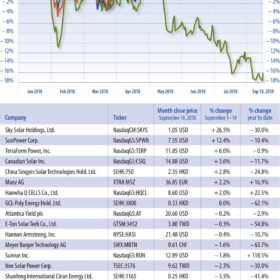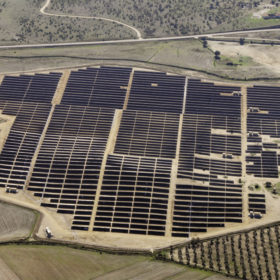Silicon and inverters slip
Month-to-date (MTD), the Guggenheim Solar ETF (TAN) was down 3.5%, underperforming the broader market, which saw the S&P 500 and Dow up 0.1% and 1.1% respectively.
How long can a boom last?
The Australian solar market has experienced an extraordinary boom over the last two years, but there are serious question marks hanging over how long these good times might last.
Everything must go?!
It’s official: as of September 3, the minimum import price is relegated to history! After the majority of EU representatives consulted in preliminary talks spoke out against further market restrictions, the Commission is refraining from a further review of possible acts of price dumping by Chinese manufacturers. In the context of protectionist measures in the USA […]
Module reshuffle
In August 2013, in order to protect its own development in PV production, the EU introduced antidumping and anti-subsidy policies on Chinese-made PV modules and cells. A minimum import price (MIP) restriction was also imposed on these products.
Off-grid solar, the industry’s often unappreciated stabilizer
Grid-connected applications may be where the money is, and isn’t, but once upon a solar time off-grid was the dominant application in the PV industry. Nowadays it is considered a quaint niche application, and is often ignored in analyses. This is shortsighted, as all grid-connected business models have their roots in off-grid deployment. Village grids, for example, are the great grandparent of today’s microgrid and community solar.
Solar takes the lion’s share
During August 2018, Australia passed an important landmark in its renewable energy project pipeline, writes Ben Willacy, Senior Analyst at Rystad Energy. The local renewable energy sector now has 300 utility-scale solar operations and projects at various stages of completion, reflecting a remarkable expansion in renewable project development.
The MIP comes to an end
On August 21, the majority of EU member states rejected the request for the initiation of expiry reviews with regards to the antidumping and anti-subsidy measures for crystalline solar PV modules and cells originated in or consigned from the People’s Republic of China. As such, the undertaking on the minimum import price (MIP) expired on September 3, after almost five years in place. Here, Edurne Zoco, Research Director at IHS Markit looks at the changes this will likely bring to Europe’s PV market.
“We need to bring the whole community with us”
Some may have despaired when Australia’s National Energy Guarantee floundered, stumbled, and ultimately fell. Not the Smart Energy Council’s Chief Executive John Grimes, who claims to have ‘called it,’ on behalf of his members, as a renewables-killing policy.
A good chance of certainty within 18 months
There were some who believed that Australia’s proposed National Energy Guarantee (NEG) was better than nothing. But others, like renewable energy analyst and investor Simon Holmes à Court, were relentless in their castigation of the policy. Now with the NEG more or less dead and buried, he believes we’re closer to good policy than before.
From rooftops to innovative PPA structures: Australia’s universities go solar
This 1.77 MW installation on the rooftop of Charles Sturt University’s campus in the Australian Capital Territory covers approximately 20% of the electricity needs of the campus.










